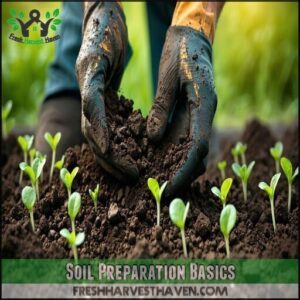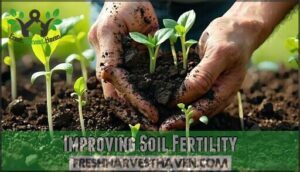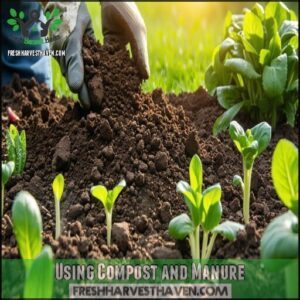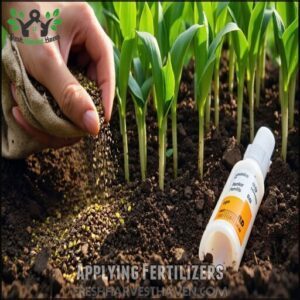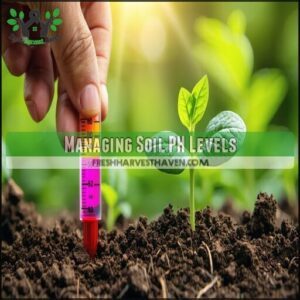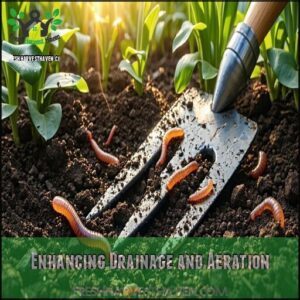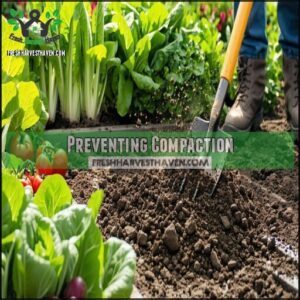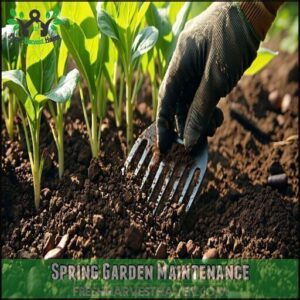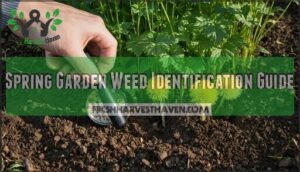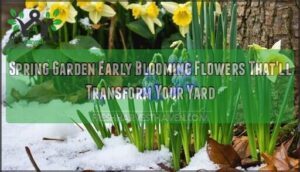This site is supported by our readers. We may earn a commission, at no cost to you, if you purchase through links.
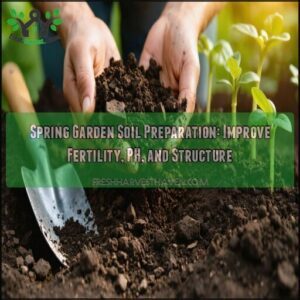 Spring garden soil preparation is key to a thriving garden.
Spring garden soil preparation is key to a thriving garden.
Start by clearing old plant debris and weeds—your soil needs a fresh canvas.
Test the soil’s condition to check pH and texture; you want a balance that lets roots breathe but holds moisture.
Add organic matter, like compost or aged manure, to boost fertility and improve structure.
If water pools or runs off, loosen compacted areas with a garden fork to improve drainage.
Don’t forget to adjust pH with lime or sulfur if needed to ensure a healthy balance.
A little effort now sets the stage for healthier plants and a fruitful growing season ahead!
Table Of Contents
- Key Takeaways
- Soil Preparation Basics
- Improving Soil Fertility
- Soil Structure Optimization
- Spring Garden Maintenance
- Frequently Asked Questions (FAQs)
- How do you prepare garden soil for spring planting?
- When should I start preparing my garden for spring?
- How do you amend garden soil in the spring?
- What should I add to raised bed soil in spring?
- How do you prepare soil for spring vegetable garden?
- When should I start prepping my spring garden?
- What nutrients to add to soil in spring?
- Is your soil ready for spring planting?
- How should you prepare soil for spring planting?
- How do I start a spring vegetable garden?
- Conclusion
Key Takeaways
- Clear out weeds, old plants, and debris to give your soil a fresh start.
- Mix in compost or aged manure to boost nutrients and improve soil structure.
- Test your soil’s pH and texture to ensure proper balance and drainage.
- Loosen compacted areas with a garden fork to improve aeration and water flow.
Soil Preparation Basics
Preparing your garden soil sets the stage for healthy plants and a productive season.
Preparing your soil is the first step to vibrant plants, stronger roots, and a season full of growth and abundance.
Start by clearing beds, removing debris, and evaluating soil conditions to create a solid foundation for growth.
Clearing Garden Beds
Start your spring garden soil preparation by clearing garden beds thoroughly. Remove old mulch and rake debris to expose the soil.
Use a spade for sod removal, and disinfect tools to avoid spreading diseases. Leave edible weeds like dandelions if they belong elsewhere.
Preparing garden beds properly sets a strong foundation—clean beds mean healthy plants and fewer problems later.
To further improve soil health, consider adding well-rotted organic matter to create a strong foundation.
Removing Debris and Weeds
Clearing weeds and debris is essential during spring garden prep.
Identify weeds early to stop their spread. Use the right tools, like a spade or hoe, for weed removal while minimizing soil disturbance.
Dispose of debris properly to avoid pest issues.
Preventative measures, like a mulch layer, help keep weeds at bay, aiding efficient garden soil preparation and healthier plants.
Assessing Soil Condition
Before planting, check your spring garden soil.
Start with a visual inspection—look for uneven soil texture or poor drainage. Do a simple compaction test by squeezing soil; crumbly is good, brick-like isn’t.
Dig in and count earthworms—more worms mean healthier soil condition.
Soil testing reveals pH and nutrients, ensuring plants thrive, and this step is crucial for preventing planting headaches later, by evaluating the soil to ensure it is suitable for the plants.
Improving Soil Fertility
To improve your soil’s fertility, focus on adding nutrient-rich organic matter, like compost or aged manure.
Boost soil fertility naturally with nutrient-rich compost or aged manure—nurture healthy plants for a thriving, productive garden season.
Using natural fertilizers guarantees your plants get the essential nutrients they need for strong growth and bountiful harvests.
Adding Organic Matter
Once your soil is cleared, it’s time to boost its health with organic material.
Add compost, aged manure, or worm castings to increase soil organic matter. These amendments improve soil structure, water retention, and nutrient availability.
Consider using garden compost products for superior results.
Think of it as feeding your garden—it gives plants the energy they need to grow strong and productive, season after season, with superior results.
Using Compost and Manure
Compost and manure are game-changers for spring soil preparation, boosting fertility with rich nutrient content.
Spread 2–3 inches of compost or aged manure, mixing it into the soil.
Opt for well-composted manure to avoid weed seeds or pathogens, and look for affordable sourcing options locally.
Consider garden compost options for best results, as these soil amendments improve structure, retain moisture, and support healthy plant growth throughout spring, making them a valuable tool for spring soil preparation.
Applying Fertilizers
After enriching the soil with compost and manure, it’s time to focus on fertilizer application.
Start by understanding fertilizer types and your soil’s nutrient ratios through a test.
Apply fertilizers in spring when the soil warms up, mixing them into the top 3-5 inches.
Use organic options if possible, avoid over-fertilization, and make certain plants receive balanced macro and micronutrients.
Consider using eggshell water fertilizer to boost calcium levels.
Soil Structure Optimization
Optimizing soil structure helps roots grow deeper, improving water flow and air circulation.
By loosening compacted soil and preventing future compression, you’ll create the perfect environment for strong, healthy plants.
Managing Soil PH Levels
To keep plants happy, you’ve got to monitor soil pH levels. Most thrive in a 6.0–7.0 range.
Start with a soil pH test kit to check acidity or alkalinity. If the soil is too acidic, add lime to balance it. Too alkaline? Use sulfur.
Remember, organic matter improves water retention and feeds microorganisms. Remember, soil pH adjustment guarantees proper nutrient availability and healthier plants.
Enhancing Drainage and Aeration
Improving your garden’s soil drainage and aeration isn’t rocket science.
Loosen compacted soil with a shovel or fork, and consider raised beds for better structure. Amendments like compost, perlite, or sand boost moisture balance.
Deep watering practices help prevent waterlogging. Consider using specialized aeration equipment for ideal results.
Proper soil loosening and aeration keep roots healthy, ensuring your plants thrive with better nutrient absorption, which is crucial for healthy plants.
Preventing Compaction
Avoid wet soil when working your garden—it compacts easily and harms soil structure.
To prevent soil compaction, try these tips:
- Use a broadfork to loosen soil without over-tilling, improving soil aeration and drainage.
- Build raised beds to minimize foot traffic and maintain healthy soil.
- Incorporate soil amendments like compost to keep soil loose and promote better root growth.
Spring Garden Maintenance
Keep your spring garden thriving by tackling essential maintenance tasks like managing weeds and pests, applying mulch, and monitoring soil health.
These simple steps set the stage for healthy plants and a productive growing season.
Controlling Weeds and Pests
Spotting weeds early is essential for better weed control.
Dig out roots completely or compost them to avoid spreading seeds.
Tackle garden pests by encouraging beneficial insects like ladybugs for natural pest control.
Prevent soil pests with healthy soil and proper practices.
Here’s a quick guide below:
| Task | Tools Needed | Goal |
|---|---|---|
| Weed Identification | Gloves, Spade | Spot early weeds |
| Pest Prevention | Neem Oil, Spray | Block harmful insects |
| Organic Controls | Compost, Mulch | Boost soil health |
| Beneficial Insects | Habitat Plants | Attract natural allies |
| Soil Pests | Compost, Rotation | Improve soil resilience |
The key to successful gardening is spotting weeds early, natural pest control, healthy soil, beneficial insects, and proper practices.
Applying Mulch and Repellents
Mulch is your garden’s superhero, locking in moisture and suppressing weeds.
Choose mulch types like straw, bark, or compost for your needs.
Repellent granules help keep moles and other garden pests at bay. Spread a thick layer around plants, and don’t skimp on edges.
Balanced repellent application guarantees pest deterrents work without harming beneficial creatures.
Monitoring Soil Health and Moisture
Keep your soil healthy by checking moisture levels and testing periodically. A well-balanced soil structure enhances microbial activity and nutrient retention.
Here’s a quick checklist:
- Test soil moisture by hand—damp, not soggy, is ideal.
- Use a soil testing kit to monitor pH and nutrients.
- Observe daily for overwatering signs.
- Improve moisture retention with organic matter.
- Reassess every spring.
Remember to amend soil yearly with compost to maintain a healthy soil structure and support nutrient retention and overall soil health, ensuring well-balanced conditions.
Frequently Asked Questions (FAQs)
How do you prepare garden soil for spring planting?
Start by loosening the soil with a spade or fork, removing rocks and debris.
Mix in compost or aged manure for nutrients.
Test pH levels, verify proper drainage, and create leveled beds for smooth planting.
When should I start preparing my garden for spring?
As winter’s chill fades, prepare your garden 4-6 weeks before the last frost.
Loosen soil, remove debris, and add compost.
Early preparation lets your garden wake up strong, ready for a fruitful spring season.
How do you amend garden soil in the spring?
To amend your garden soil in spring, mix in compost, aged manure, or organic fertilizers.
Work these into the top 6–8 inches of soil, improving nutrients, structure, and drainage.
Avoid over-amending to prevent imbalance.
What should I add to raised bed soil in spring?
Did you know raised beds can boost plant growth by up to 50%?
In spring, add 2-3 inches of compost, aged manure, or organic matter to improve soil structure, boost nutrients, and retain moisture.
How do you prepare soil for spring vegetable garden?
Loosen soil to 8-12 inches, mix in 2-3 inches of compost, and remove weeds or debris.
Test pH, adjust with lime or sulfur if needed, then rake smooth for even planting.
When should I start prepping my spring garden?
Start prepping your spring garden as soon as the ground feels workable—neither frozen nor too muddy.
Test the soil, clear debris, and add compost to wake it up for planting.
It’s all about timing!
What nutrients to add to soil in spring?
Boost spring soil by mixing in compost, aged manure, or worm castings.
Sprinkle organic fertilizer rich in nitrogen, phosphorus, and potassium.
These nutrients fuel plant growth, ensuring strong roots, lush leaves, and abundant harvests.
Is your soil ready for spring planting?
Your soil’s ready if it’s loose, free of weeds, and enriched with compost or nutrients.
Test its pH for balance, and make certain good drainage.
Healthy soil means happy plants and a thriving garden!
How should you prepare soil for spring planting?
Turn over the garden soil to a depth of 6-8 inches, mixing in compost or aged manure.
Remove weeds, rocks, and debris, and level the surface.
Test soil pH to guarantee the best nutrient availability for plants.
How do I start a spring vegetable garden?
Picture fresh veggies thriving outside your window.
Clear grass, loosen soil to 12 inches, mix in compost for nutrients.
Plan rows or raised beds, test the pH, and plant seeds suited to your climate.
Conclusion
Did you know healthy soil can increase plant yields by up to 30%?
With proper spring garden soil preparation, you’re setting yourself up for a garden that thrives.
Clear debris, check your soil’s pH, and mix in organic matter to boost fertility and structure.
Loosen compacted areas to improve drainage, and monitor moisture levels to keep plants happy.
A little work now guarantees your soil stays rich and balanced, leading to a productive growing season with proper spring garden soil preparation.
- https://libguides.nybg.org/vegetablegarden
- https://www.americanmeadows.com/content/early-spring-soil-preparation?srsltid=AfmBOoo6GJzgSDNweqBzHIytAZxWyM5AIWm4uPoPBRb8VYXP_RNDIeIv
- https://foodrevolution.org/blog/preparing-garden-soil-for-spring/
- https://www.epicgardening.com/prepare-soil-for-spring/
- https://bonnieplants.com/blogs/garden-fundamentals/prep-soil-now-for-next-season

